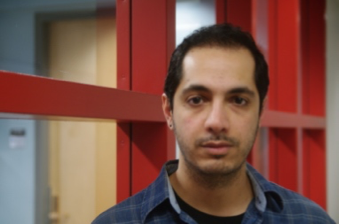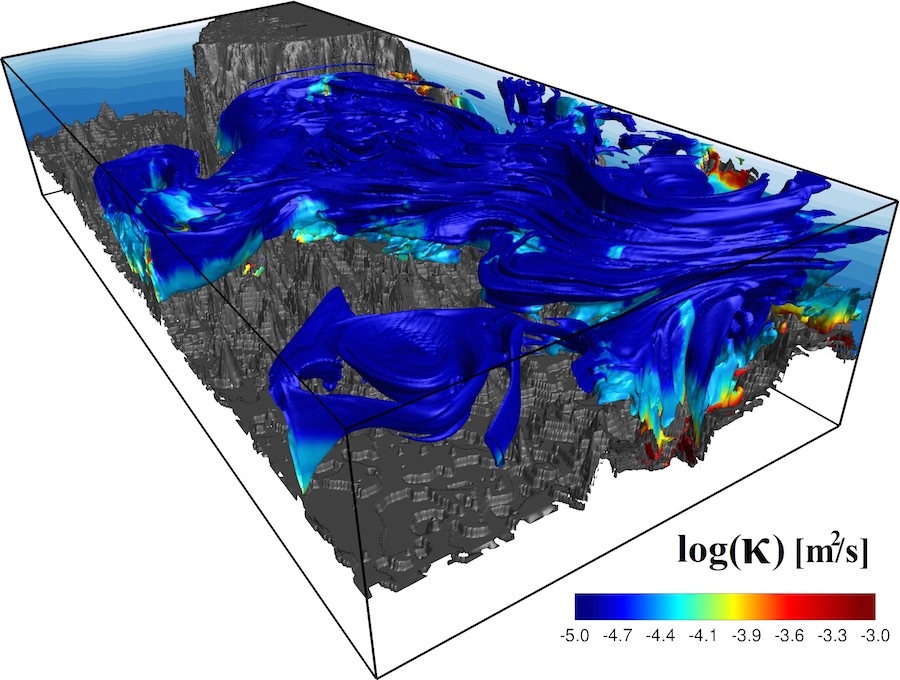story by Helen Hill

This month we report on work by Ali Mashayek and Raf Ferrari of MIT who have been using MITgcm to help them understand what sets the density structure and rate of overturning in the ocean.
It is commonly believed that turbulence induced by wave breaking in the ocean interior is responsible for upwelling of abyssal waters which form and sink to depth at high latitudes (in the Labrador sea to the north and Weddell and Ross seas to the south). New work presented at Ocean Sciences in February 2016 shows that this picture could be upside down: internal wave breaking actually leading to downwelling of waters in the ocean interior accompanied by strong upwelling in thin (order of 10s of meters thick) boundary layers in the deep ocean around continental margins and mid-ocean ridges. Such a finding has important implications for the closure of the ocean meridional overturning circulation, a key regulator of the global heat and carbon budgets. More specifically it impacts the timescale over which waters sink into the deep ocean and when and where that water resurfaces with important implications for the rate tracers such as heat and carbon can be re-distributed around the globe and hence climate.
To verify that mixing in a topographically rough region of the ocean is bottom enhanced (to the extent that its influence extends all the way up to mid-depths and thereby drives the Southern Ocean branch of the global ocean meridional overturning circulation) Mashayek and Ferrari set up a realistic, very high resolution configuration of MITgcm for the Drake Passage region in the Southern Ocean and integrated data from the DIMES field program.
Drake Passage DIMES tracer simulation on youtube – animation credit: A. Mashayek

Ali Mashayek is a postdoc working with Raf Ferrari at MIT. He has been using MITgcm since 2013. When not hard at work trying to figure out how the ocean works he enjoys cooking and reading.
The movie shows time evolution of a simulated anthropogenic tracer release into a domain modeled on the Drake Passage. In the field, sampling of the tracer was done along cruises leading to very sparse sampling over time and space (once or twice a year over isolated transects in a region covering ~10,000km). In the simulation from which the movie is made, a numerical tracer initiated with observed concentrations of the real tracer was injected downstream of the channel and its match with observed concentrations sampled at the end of the computational domain verified giving confidence that the model was closely reproducing conditions in the field. The full 3D model solution was then used to quantify mixing in the Drake Passage, a climatically key region due to its role in ocean/atmosphere exchange of tracers and inter-basin and vertical exchange of water masses in the deep ocean.
To find out more about this work contact Ali.
This Month’s Featured Publications
- R. Ferrari, A. Mashayek, T. McDougall, N. Nikurashin, J-M Campin, “Turning ocean mixing upside down”, Journal of Physical Oceanography, (2015-under review) (Sub#JPO-D-15-0104)
- A. Mashayek, R. Ferrari, S. Merrifield, L. St. Laurent, J. Ledwell, A.N. Garabato (Journal of Physical Oceanography, shortly to be submitted)
Other New Publications this Month
M. Bellacicco, C. Anagnostou, F. Falcini, E. Rinaldi, K. Tripsanas, E. Salusti (2016), The 1987 Aegean dense water formation: A streamtube investigation by comparing theoretical model results, satellite, field, and numerical data with contourite distribution, Marine Geology, doi: 10.1016/j.margeo.2016.01.012
Maarten C. Buijsman, Joseph K. Ansong, Brian K. Arbic, James G. Richman, Jay F. Shriver, Patrick G. Timko, Alan J. Wallcraft, Caitlin B. Whalen, ZhongXiang Zhao (2016), Full Access Impact of parameterized internal wave drag on the semidiurnal energy balance in a global ocean circulation model, Journal of Physical Oceanography, published online Feburay 2016, doi: 10.1175/JPO-D-15-0074.1
Ayan H. Chaudhuri, Rui M. Ponte, Gael Forget (2016), Impact of uncertainties in atmospheric boundary conditions on ocean model solutions, Ocean Modelling, Volume 100, April 2016, pp. 96-108, doi: 10.1016/j.ocemod.2016.02.003
Judith Hauck, Peter Köhler, Dieter Wolf-Gladrow and Christoph Völker (2016), Iron fertilisation and century-scale effects of open ocean dissolution of olivine in a simulated CO2 removal experiment, Environmental Research Letters, Volume 11, Number 2, doi: 10.1088/1748-9326/11/2/024007
Jones, C.S., and P. Cessi (2016), Interbasin transport of the meridional overturning circulation, Journal of Physical Oceanography, doi: 10.1175/JPO-D-15-0197.1
Matthew . Martin (2016), Suitability of satellite sea surface salinity data for use in assessing and correcting ocean forecasts, Remote Sencing of Environment, Available online 15 February 2016, doi: 10.1016/j.rse.2016.02.004
R. C. Musgrave, J. A. MacKinnon, R. Pinkel, A. F. Waterhouse, J.Nash (2016), Full Access Tidally Driven Processes Leading to Near-Field Turbulence in a Channel at the Crest of the Mendocino Escarpment, Journal of Physical Oceanography, doi: 10.1175/JPO-D-15-0021.1
Vivien Parmentier, Jonathen J. Fortney, Adam P. Showman, Caroline Morley, Mark S. Marley (2016), A Transition in the Composition of Clouds in Hot Jupiters, Submitted to Astrophysical Journal, http://arxiv.org/pdf/1602.03088.pdf
Helen R. Pillar, Patrick Heimbach, Helen L. Johnson, David P. Marshall (2016), Full Access Dynamical attribution of recent variability in Atlantic overturning, Journal of Climate, Online February 15, 2016, doi: 10.1175/JCLI-D-15-0727.1
J. She, I. Allen, E. Buch, A. Crise, J. A. Johannessen, P. Y. Le Traon, U. Lips, G. Nolan, N. Pinardi, J. H. Reißmann, J. Siddorn, E. Stanev, and H. Wehde (2016), Developing European operational oceanography for Blue Growth, climate change adaptation and mitigation and ecosystem-based management, Ocean Sci. Discuss., doi: 10.5194/os-2015-103
B.J. Weiß, C. Hübscher, T. Lüdmann, N. Serra (2016), Submarine sedimentation processes in the southeastern Terceira Rift/São Miguel region (Azores), Marine Geology, Volume 374, 1 April 2016, Pages 42–58, doi: 10.1016/j.margeo.2016.02.004
Changshui Xia , KyungTae Jung, Guansuo Wang, Xunqiang Yin, Jingsong Guo (2016), Case study on the three-dimensional structure of meso-scale eddy in the South China Sea based on a high-resolution model, Acta Oceanologica Sinica, February 2016, Volume 35, Issue 2, pp 29-38, doi: 10.1007/s13131-016-0805-1
Do you have news about research using MITgcm? We are looking for contributions to these pages. If you have an interesting MITgcm project (ocean, atmosphere, sea-ice, physics, biology or otherwise) that you want to tell people about, get in touch. To make a post, contact Helen

